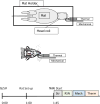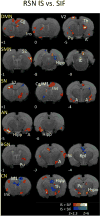Brain network alterations in the inflammatory soup animal model of migraine
- PMID: 28167076
- PMCID: PMC5731648
- DOI: 10.1016/j.brainres.2017.02.001
Brain network alterations in the inflammatory soup animal model of migraine
Abstract
Advances in our understanding of the human pain experience have shifted much of the focus of pain research from the periphery to the brain. Current hypotheses suggest that the progression of migraine depends on abnormal functioning of neurons in multiple brain regions. Accordingly, we sought to capture functional brain changes induced by the application of an inflammatory cocktail known as inflammatory soup (IS), to the dura mater across multiple brain networks. Specifically, we aimed to determine whether IS alters additional neural networks indirectly related to the primary nociceptive pathways via the spinal cord to the thalamus and cortex. IS comprises an acidic combination of bradykinin, serotonin, histamine and prostaglandin PGE2 and was introduced to basic pain research as a tool to activate and sensitize peripheral nociceptors when studying pathological pain conditions associated with allodynia and hyperalgesia. Using this model of intracranial pain, we found that dural application of IS in awake, fully conscious, rats enhanced thalamic, hypothalamic, hippocampal and somatosensory cortex responses to mechanical stimulation of the face (compared to sham synthetic interstitial fluid administration). Furthermore, resting state MRI data revealed altered functional connectivity in a number of networks previously identified in clinical chronic pain populations. These included the default mode, sensorimotor, interoceptive (Salience) and autonomic networks. The findings suggest that activation and sensitization of meningeal nociceptors by IS can enhance the extent to which the brain processes nociceptive signaling, define new level of modulation of affective and cognitive responses to pain; set new tone for hypothalamic regulation of autonomic outflow to the cranium; and change cerebellar functions.
Keywords: Inflammatory soup; Migraine; Rat; Resting state networks; fMRI.
Copyright © 2017. Published by Elsevier B.V.
Conflict of interest statement
The authors declare no competing financial interests.
Figures




References
Publication types
MeSH terms
Grants and funding
LinkOut - more resources
Full Text Sources
Other Literature Sources
Medical

